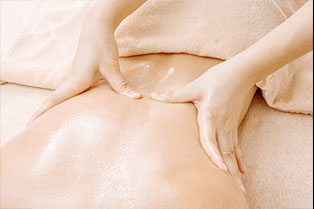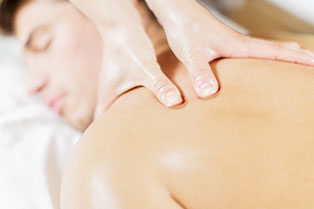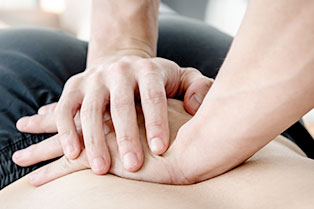 |
02 8283 5811 L1/553 Willoughby Rd, Willoughby, NSW 2068 Open 7 Days : 10 am. - 9 pm. |
 |
02 8283 5811 L1/553 Willoughby Rd, Willoughby, NSW 2068 Open 7 Days : 10 am. - 9 pm. |
 Low Back Pain Low Back Pain |
 Neck Pain Neck Pain |
 Shoulder Pain Shoulder Pain |
Remedial Massage purpose & beneffiits
A remedial massage is designed to balance muscle length, tension and tone which will in turn will promote the return of normal joint, capsular and bone position. The increase in the ffllow of blood and lymph fflluid, particularly to injured areas, heals muscles and removes blockages, damaged cells, scar tissue and adhesions resulting from injury and dysfunction.
| 60mins | 90mins | 120mins | |
|
Remedial Massage Remedial Massage is a treatment modality that manipulates the soft tissues of the body including movement for a specific therapeutic effect, rather than a general therapeutic effect. It uses relevant techniques, lubricants and movements according to the client's needs and response. |
$105 | $150 | $195 |
|
Deep Oil + Hot Stone Deep Oil + Hot Stone Massage is a style of deep tissue massage in which water treated stones are placed at specific sites on the body, helps to promote relaxation. |
$105 | $150 | $195 |
| Swedish Massage | $95 | $145 | $185 |
|
Deep Oil Massage Deep Oil Massage is a process-oriented bodywork combining deep tissue massage with oil, body movement and awareness as well as emotional expression. |
$95 | $145 | $185 |
| 30 mins | 60 mins | 90 mins | |
| Foot Reffllexology | $50 | $80 | - |
| Foot Scrub & Treatment | - | $85 | $105 |
| 30 mins | 5 visits | 10 visits | |
|
Ear Candle (Plus Neck, Shoulder & Head Massage) |
$50 | $210 | $360 |

Swedish massage may be the ffiirst thing that springs to mind when you think about massage. This type of massage focuses on deep and complete relaxation but can also be used to release cramped muscles. Swedish massage uses a number of different techniques, including the following:
Swedish massage is an excellent choice for stress relief and for people who experience the whole body pain of muscle cramping. Therapists gently help sore, tense muscles release so that the patient can feel some relief and rest.
 Deep tissue massage is not for everyone. Just as it sounds, this type of massage features a massage therapist who goes deeply into each sore muscle, reaching as far down through the muscle to the bone as possible. This can help to release scar tissue and assist in relaxing tightly knotted muscles that can cause chronic neck and upper back pain. Deep tissue massage uses many of the same techniques as Swedish massage. In this type of massage, it is crucial that you speak up while you are on the table. While this is not the same type of deeply relaxing massage as a Swedish massage, you should not be in so much pain that you cannot let your knotted muscles release. Qualiffiied deep tissue therapists are happy to vary their levels at your request, including starting lightly and going deeply over the course of the massage. Deep tissue massage is excellent for people with chronic pain due to a build-up of scar tissue or those with stiff, painful areas in the neck, shoulders, and back. You should expect to feel sore for a few days after the massage, but a warm bath with Epsom salts can help with that.
Deep tissue massage is not for everyone. Just as it sounds, this type of massage features a massage therapist who goes deeply into each sore muscle, reaching as far down through the muscle to the bone as possible. This can help to release scar tissue and assist in relaxing tightly knotted muscles that can cause chronic neck and upper back pain. Deep tissue massage uses many of the same techniques as Swedish massage. In this type of massage, it is crucial that you speak up while you are on the table. While this is not the same type of deeply relaxing massage as a Swedish massage, you should not be in so much pain that you cannot let your knotted muscles release. Qualiffiied deep tissue therapists are happy to vary their levels at your request, including starting lightly and going deeply over the course of the massage. Deep tissue massage is excellent for people with chronic pain due to a build-up of scar tissue or those with stiff, painful areas in the neck, shoulders, and back. You should expect to feel sore for a few days after the massage, but a warm bath with Epsom salts can help with that.
 Trigger point massage is similar to deep tissue in that is goes much more deeply into the muscle than Swedish massage. The goal of trigger point massage is to identify and release a tight point within a tight muscle: the trigger point. Trigger points are tight areas within a muscle that cause pain in another area of the body. For example, a trigger point in the neck may cause migraine pain, or one in the back may cause radiating pain down the leg leading to sciatica. Trigger point massage does not necessarily work the entire body or the entire length of a muscle. The emphasis is on releasing the speciffiic trigger point to alleviate pain. This is done by adding deep pressure to the trigger point and then releasing it, over and over again until the trigger point releases. This type of massage is best for chronic muscle pain and tension, as well as migraines brought on by muscle tension.
Trigger point massage is similar to deep tissue in that is goes much more deeply into the muscle than Swedish massage. The goal of trigger point massage is to identify and release a tight point within a tight muscle: the trigger point. Trigger points are tight areas within a muscle that cause pain in another area of the body. For example, a trigger point in the neck may cause migraine pain, or one in the back may cause radiating pain down the leg leading to sciatica. Trigger point massage does not necessarily work the entire body or the entire length of a muscle. The emphasis is on releasing the speciffiic trigger point to alleviate pain. This is done by adding deep pressure to the trigger point and then releasing it, over and over again until the trigger point releases. This type of massage is best for chronic muscle pain and tension, as well as migraines brought on by muscle tension.
 Myofascial release is similar to trigger point massage. It targets trigger points in the fascia to relieve pain throughout the body. Because the fascia, the thin layer of connective tissue that covers all of the muscles in the body, connects to every muscle in the body, myofascial release focuses on a broad expanse of muscle all over the body. The massage therapist will ffiirst gently massage all over the body. They’ll feel for any spots of tension or tightness in the fascia. Under normal conditions, fascia should be pliable. If there are areas of tightness, the therapist will work those areas gently, increasing pressure across the area as the fascia begins to release. You can practice this technique on your own at home using rigid foam rollers on legs, arms, and backs. For plantar fasciitis, a tennis ball rolled along all three arches of the feet can help release fascial tension. This massage technique can be pain relieving for those who suffer from ffiibromyalgia, but it will not necessarily be relaxing on the table. Myofascial release is also indicated as a treatment for chronic fatigue syndrome.
Myofascial release is similar to trigger point massage. It targets trigger points in the fascia to relieve pain throughout the body. Because the fascia, the thin layer of connective tissue that covers all of the muscles in the body, connects to every muscle in the body, myofascial release focuses on a broad expanse of muscle all over the body. The massage therapist will ffiirst gently massage all over the body. They’ll feel for any spots of tension or tightness in the fascia. Under normal conditions, fascia should be pliable. If there are areas of tightness, the therapist will work those areas gently, increasing pressure across the area as the fascia begins to release. You can practice this technique on your own at home using rigid foam rollers on legs, arms, and backs. For plantar fasciitis, a tennis ball rolled along all three arches of the feet can help release fascial tension. This massage technique can be pain relieving for those who suffer from ffiibromyalgia, but it will not necessarily be relaxing on the table. Myofascial release is also indicated as a treatment for chronic fatigue syndrome.